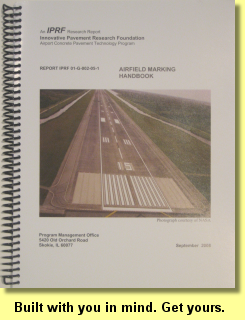 |
 |
Airfield Marking Handbook - Chapter 2By Mike Speidel
This issue kicks off the first of a six article series summarizing each chapter contained within the Handbook. As the principal authors of the Airfield Marking Handbook, we will also be identifying key issues for your consideration.
Design and Specification Development for Construction and Maintenance Activities The design and development of specifications for new or maintenance projects must be written with several factors in consideration. What is written in the specifications often determines whether a job is a success. During the design of a project that either (a) includes airfield markings as part of the overall project or (b) is for the maintenance of airfield markings, the engineer must consider certain aspects of the work.
Under Appendix A of the Handbook, there is a sample specification designed to improve marking performance. A checklist of items to cover during the design stage is included under Appendix E. 
There is discussion about material selection, verification of materials, and about implementing a quality control plan to measure expectations for the project. Differences between a new marking project and the maintenance of existing markings are discussed, and how each should be approached in the design stage. But one of the most significant revelations is to evaluate the condition of asphalt pavement under old markings, and prescribe the right solution for the condition found. When repainting or maintaining existing markings, it is important to create detailed specifications to call for surface preparation when necessary, suitable materials tailored to the environment, and in the event of paint build up or obsolete lines, paint removal. In addition, specifications should consider pavement type and its condition in order to prevent pavement damage and/or deterioration. It is during the design stage where communication between personnel responsible for inspection, and personnel responsible for writing the specifications is paramount. Engineers who write project specifications do so from their office. Inspectors (often operations personnel) see the pavement, joints, lights, and markings on a daily basis. An inspector with a trained eye can inform a design team about problems that have been detected. The designers can then address those issues in the project specifications to resolve them. Procurement of the Airfield Marking Handbook:
|

 With the Airfield Marking Handbook hot off the presses and now being distributed to the industry, let's take a look at
what's inside. In each of the next several issues of Sightline's webletter, I'm going to take a look at each chapter and it's
highlights. It's the most comprehensive resource available dealing strictly with airfield markings. Information on
how to procure a copy is at the bottom of this article.
With the Airfield Marking Handbook hot off the presses and now being distributed to the industry, let's take a look at
what's inside. In each of the next several issues of Sightline's webletter, I'm going to take a look at each chapter and it's
highlights. It's the most comprehensive resource available dealing strictly with airfield markings. Information on
how to procure a copy is at the bottom of this article.